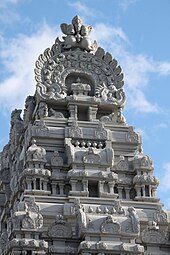Hinduism in the United States
[1] Hindu Americans came to the United States mainly from India, Nepal, Sri Lanka, Bangladesh, and the Caribbean, while there are also many local converts and followers.
A small minority of Hindu Americans come from Bhutan, Pakistan, Afghanistan, Canada, Africa, Europe, Oceania, and other countries.
In the 2023–24 Pew Research Center Religious Landscape Study, Hindus comprise approximately 0.9% of the U.S. adult population, which has increased from 0.4% in 2007.
According to the Pew Research Center, 9% of Hindus in United States belong to a non-Asian ethnicity: White (4%), Black (2%), Latino (1%) and mixed (2%).
[28] Among the first was the American philosopher Ralph Waldo Emerson, who in 1857 published a poem, "Brahma," in the first issue of the literary magazine The Atlantic Monthly, which he had helped to found.
[30][31] Anandibai Joshi is believed to be the first Hindu woman to set foot on American soil, arriving in New York in June 1883 at the age of 19.
[32] Swami Vivekananda's address to the World's Parliament of Religions in Chicago in 1893 was one of the first major discussions of Hinduism in the United States.
[34] In 1893, Swami Vivekananda gave several lectures at the Chicago World Parliament of Religions, and effectively introduced Hinduism in the United States.
[38] Around 1857, the American poet-philosopher Ralph Waldo Emerson, who led the Transcendentalist movement of the mid-19th century, studied the Hindu scripture Bhagavad Gita,[39] which is a central text in Hinduism and a synthesis of various strands of Hindu religious thought, including the Vedic concept of dharma (duty, rightful action); samkhya-based yoga and jnana (knowledge); and bhakti (devotion).
[43] In the 20th century, an American scholar of Hindu philosophy, Gerald James Larson,[44] who was a Professor of Indian Cultures and Civilization at Indiana University, Bloomington as well as Professor of Religious Studies at the University of California, Santa Barbara,[45] stated that "if there is any one text that comes near to embodying the totality of what it is to be a Hindu, it would be the Bhagavad Gita.
[48] People involved in the counter-culture such as Ram Dass, George Harrison, and Allen Ginsberg were influential in the spread of Hinduism in the United States.
Ram Dass was a Harvard professor known as Richard Alpert who traveled to India in 1967 and studied under Neem Karoli Baba.
Harrison started to record songs with the words "Hari Krishna" in the lyrics and was widely responsible for popularizing Hinduism in America in the 1960s and 1970s.
Allen Ginsberg, the author of Howl, was heavily involved with Hinduism in the 1960s and it was said that he chanted "Om" at The Human Be-in of 1967 for hours on end.
[54] In 2008, according to Pew Research Center, 80% of American adults who were raised as Hindus continued to adhere to Hinduism, which is the highest retention rate for any religion in America.
[62] The Maha Vallabha Ganapathi Devastanam, owned by the Hindu Temple Society of North America in Flushing, New York, was consecrated on July 4, 1977.
[73] Parashakthi Temple[74] in Pontiac, Michigan, is a tirtha peetham for Goddess "Shakthi," or the "Great Divine Mother" in Hinduism.
[79] In September 2000, a joint session of Congress was opened with a prayer in Sanskrit (with some Hindi and English added), by Venkatachalapathi Samudrala to honor the visit of Indian Prime Minister Atal Bihari Vajpayee.
[82] In October 2009, President Barack Obama lit a ceremonial Diwali lamp at the White House to symbolize victory of light over darkness.
In April 2009, President Obama appointed Anju Bhargava, a management consultant and pioneer community builder, to serve as a member of his inaugural Advisory Council on Faith Based and Neighborhood Partnership.
[85] In recent years, the political participation of Indian-Americans has increased with Vivek Ramaswamy being Hindu of Indian background running for the position of president in the 2024 elections from Republican Party, though he later endorsed Donald Trump.
Sentiments intensified through organizations like the Asiatic Exclusion League and widespread media portrayal of an alleged "Hindoo invasion.
[107] In September 2022, a man named Sukhpal Singh, along with 4 others, destroyed a Gandhi statue outside a Hindu temple in Queens, New York.
[109] In October 2023, burglars raided a Hindu mandir in Sacramento, California, with six suspects stealing a donation box from the premises.
[110] The incident, which took place at the Hari Om Radha Krishna Mandir in the Parkway neighborhood of Sacramento, was condemned by the Coalition of Hindus of North America as a potential hate crime.
The proceedings were interrupted by three self-professed Christian protestors, who were arrested by Capitol Police and charged with a misdemeanor for disrupting Congress.
[118] The conservative Christian group American Family Association objected to the prayer,[119] citing the loss of the "Judeo-Christian foundations" of the United States.
[121] Points of contention included a textbook's portrayal of the caste system, the Indo-Aryan migration theory, and the status of women in Indian society.









